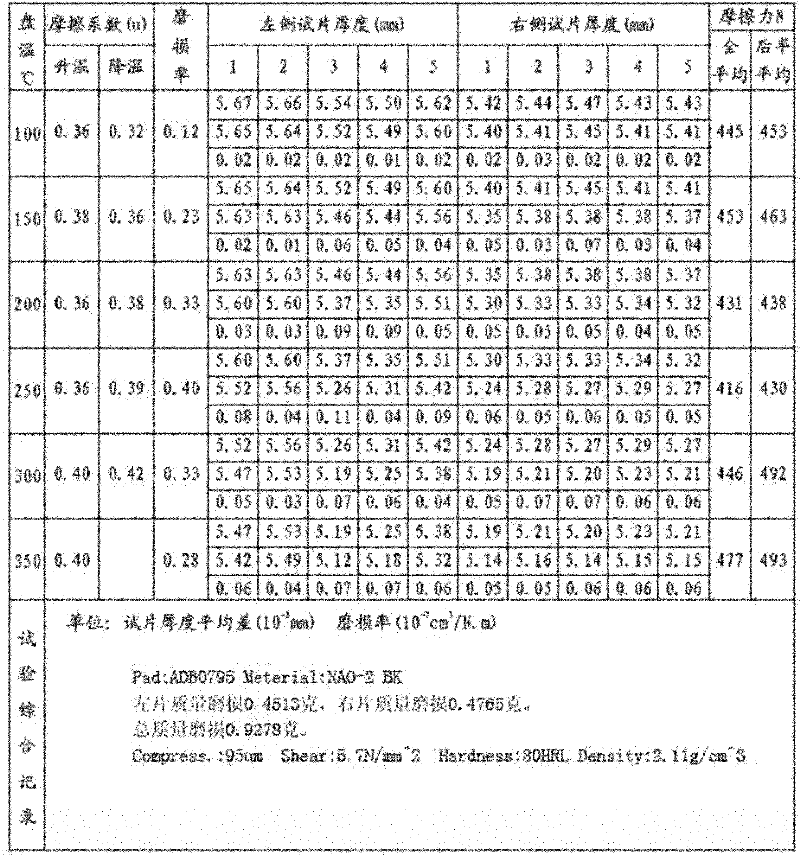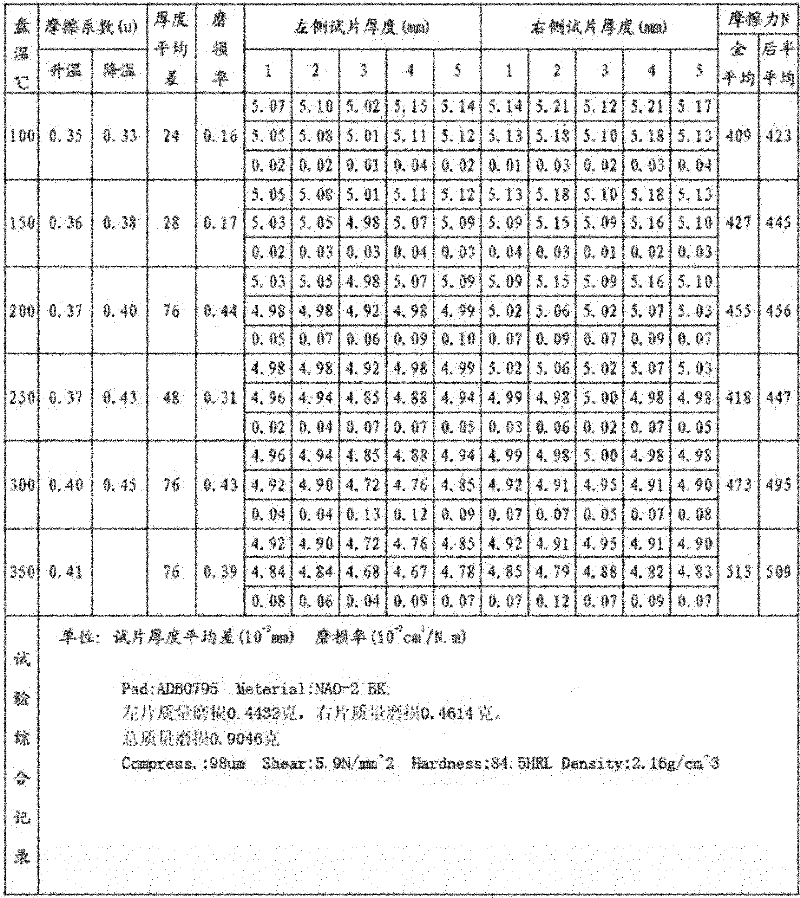Friction material for preparing NAO brake pad
A friction material and brake pad technology, applied in the field of automobile brake pads, can solve the problems of dirty appearance of the wheel hub, color pollution of the wheel hub, braking noise of the brake pad, etc., and achieve the effect of good visual effect, low wear rate and stable braking effect.
- Summary
- Abstract
- Description
- Claims
- Application Information
AI Technical Summary
Problems solved by technology
Method used
Image
Examples
Embodiment 1
[0022] Ceramic fiber 5%, mineral fiber 15%, resin 10%, chalcocite powder 6%, graphite 10%, barium sulfate 18%, biological calcification particles 5%, coke 5%, wear reducer 10%, performance adjustment Agent 5%, filler 11%, total 100%.
[0023] The above-mentioned materials were made into brake pads according to the conventional pressing method, and tested according to category 4 on a constant speed testing machine according to the GB5763-2008 standard. The results are shown in Table 1.
[0024] Table 1:
[0025]
[0026] It can be seen from the data in Table 1 that the friction coefficient of the friction material obtained in Example 1 of the present invention changes very little. In the heating stage, the friction coefficient is 0.35-0.40, and the friction coefficient is 0.33-0.44 in the cooling stage. The wear rate is small and stable at 0.11-0.25*10 -7 / N.m, the maximum value appears at 200°C, only 0.45*10 -7 / N.m, fully meet the national standard. After extensive use...
Embodiment 2
[0028] Ceramic fiber 12%, mineral fiber 6%, resin 8%, chalcocite powder 10%, graphite 15%, barium sulfate 10%, biological calcification particles 10%, coke 4%, wear reducer 10%, performance adjustment Agent 5%, filler 10%, total 100%.
[0029] The above materials were made into brake pads according to the conventional pressing method, and tested according to category 4 on a constant speed testing machine according to the GB5763-2008 standard. The results are shown in Table 2.
[0030] Table 2:
[0031]
[0032] It can be seen from the data in Table 2 that the friction material obtained in Example 2 of the present invention has a friction coefficient of 0.36-0.40 in the heating stage, and a friction coefficient of 0.32-0.42 in the cooling stage, and the wear rate is small, which fully meets the national standard. After extensive use in Santana, Sonata and Jetta taxis, the braking is smooth, the braking noise is small, and the life of the friction material has reached more t...
Embodiment 3
[0034] Ceramic Fiber 8%, Mineral Fiber 7%, Resin 6%, Chalcocite Powder 8%, Graphite 12%, Barium Sulfate 10%, Biological Calcium Granules 15%, Coke 3%, Wear Reducing Agent 13%, Performance Adjustment Agent 8%, filler 10%, total 100%.
[0035] The above materials were made into brake pads according to the conventional pressing method, and tested according to category 4 on a constant speed testing machine according to the GB5763-2008 standard. The results are shown in Table 3.
[0036] table 3:
[0037]
[0038] It can be seen from the data in Table 3 that the friction material obtained in Example 3 of the present invention has a friction coefficient of 0.35-0.41 in the heating stage and a friction coefficient of 0.33-0.45 in the cooling stage, and the wear rate is small, which fully meets the national standard. After extensive use in Santana, Sonata and Jetta taxis, the braking is smooth, the braking noise is small, and the life of the friction material has reached more than...
PUM
| Property | Measurement | Unit |
|---|---|---|
| diameter | aaaaa | aaaaa |
| diameter | aaaaa | aaaaa |
| friction coefficient | aaaaa | aaaaa |
Abstract
Description
Claims
Application Information
 Login to View More
Login to View More - R&D
- Intellectual Property
- Life Sciences
- Materials
- Tech Scout
- Unparalleled Data Quality
- Higher Quality Content
- 60% Fewer Hallucinations
Browse by: Latest US Patents, China's latest patents, Technical Efficacy Thesaurus, Application Domain, Technology Topic, Popular Technical Reports.
© 2025 PatSnap. All rights reserved.Legal|Privacy policy|Modern Slavery Act Transparency Statement|Sitemap|About US| Contact US: help@patsnap.com



